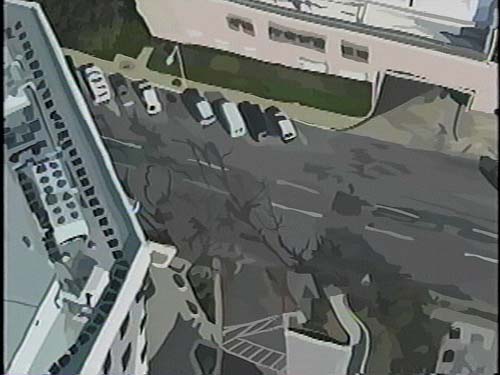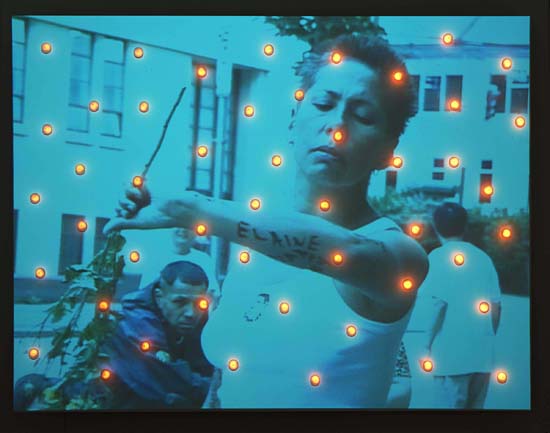
|
Lorna Mills and Sally McKay
Digital Media Tree this blog's archive OVVLvverk Lorna Mills: Artworks / Persona Volare / contact Sally McKay: GIFS / cv and contact |
View current page
...more recent posts
...[Philip] Monk proposed that, for the new art in Toronto at least, while representation can lead to action rather than to the mere contemplation allowed by formalist modernism, it is nevertheless only women artists who, in Monk's estimation, have shown a genuine and authoritative acquisition of representation and all that this slippery term means. [...] "The lines of difference," Monk wrote, "…are really between a passive resignation and melancholy despair, pessimism, nihilism and decadence on the one hand and the sense of the possibility of action on the other." Men, Monk insists, have given themselves over to a romantic yearning for aesthetic unity, to dreams of a fallen wholeness, to a longing for heroism; men he says, are basically expressionists. It is women who hold sway over meaningful representation." ...from "Reading Philip Monk: Analysing a complex and controversial theory about Canadian art and artists," by Gary Michael Dault in Canadian Art, Winter/December 1984, Volume 1, Number 2, p.70-73. To read the whole article, go to the Canadian Art websiteWow...cool, eh? So controversial. I wonder, is this when Philip Monk allegedly jumped the shark? I applaud Canadian Art for putting up these old articles, very helpful to anyone like me obsessed with recent Canadian art history. I spent the 2nd half of the 80s in art school in Nova Scotia. I remember Philip Monk came to give a lecture and showed slides of paintings by Joanne Tod. I liked them. I was painting at the time, and being told by staff and fellow students in no uncertain terms that I (in my self-referrential irony) was making "boy" art, and that I had to "realise that women make a different kind of work." I can still feel the flush of weird inarticulated frustration that came over me in the face of these statements. And it was kind of true, at least in the context of the painting department at my school. The only people who related to my projects were guys: faculty like Gary Neil Kenedy, who was supportive and bemused, and fellow students who were themselves tied up in knots about the impossiblity of meaning, the death of painting, and such spirals of despair. Monk's statement (as filtered through Dault) sounds preposterous, but I feel like I know something of what he meant. While venturing into ironic or self-referential territory got me slaps on the wrist from other females (the laden scrawl, "Clever girl" written in the comment book of my graduating show still stings), I was still less boxed in, and had more generative scope to play with signs and signifiers than my male fellows.
I just realised this blog is over one year old! I've changed the header image in celebration. Here's a link to my first ever post (Nov. 18, 2003).
François Lachapelle of the Canada Council has posted an open letter to Instant Coffee's email listings that responds to protest against the C.C.'s proposed changes. This quote jumps out: "The Council has lost its capacity to be generous and is therefore less able to support the 'development of the practice', the purpose of the current program as stated 40 years ago." (I've reposted the whole letter in comments below)
To over simplifiy, the Canada Council was the result of two things: the Massey Report in 1951, and six years later the deus-ex-machina-type appearance of a $53 million endowment from the Killam and Dunn estates. A great source for this history (besides [plug!] Andrew Paterson's thorough timeline in Money Value Art) is George Woodcock's Strange Bedfellows, The State and the Arts in Canada, published in 1985 by Douglas and MacIntyre. Below are some quotes from Woodcock that provide context for the issue at hand.
When the Massey Commission began its enquiries in the spring of 1946, there was no world of Canadian arts and letters of the kind that existed in European Countries and the United States, or, for that matter, of the kind that has since developed in Canada. [...] The situation was partly due to the lack of interest on the part of most Canadians , still barely out of the pioneer age, in art. But even more it was due to the lack of the kind of infrastructure which transforms a scattering of people working in virtual isolation into a really functioning artistic and literary world that reaches out to audiences both urban and rural and in all regions. (p. 46-47)
In 1949 the average budget which the National Gallery could devote to purchases of all kinds, of which the work of living Canadian artists was only a part, was a mere $32,000, and other public galleries were faced by similar limitations of scope. At the same time there existed only a rudimentary network of private galleries, and by no means did all of these attempt to sell the works of living painters. (p. 49)
[The Massey Report] showed genuine wisdom in its assessment of the great cultural lacks of Canada in the late 1940s, and the scanty resources that existed to meet them. What impressed me perhaps more than anything else was the way the commission created its own bow wave of interest, not only looking into the needs, but making people think of them, so that by the time of the report's publication the idea that the community had a responsibility towards its arts and artists was accepted without serious opposition. (p. 50)
I have often heard it said that Vincent Massey was an elitist, and that the report was an elitist document. And so, if you think in such barren terms, it probably was. But in the cultural desert of Canada at that time a group of men and women was needed who could act the elitist role and decide what seemed to be good for the arts and suggest what was good for the arts was good for the country. (p. 51)
The upsurge in the arts that characterized the later 1950s was already beginning to stir, and it ran parallel to a postwar economic resurgence which made Canadians look more confidently and more adventurously on the future than they had done at any time since the 1880s, when the building of the Canadian Pacific Railway symbolized the emergence of a pan-Canadian economy which, then also, was accompanied by modest but genuine upsurges in poetry and the visual arts [...] There is no doubt that the success of the Arts Council in Britain encouraged not only the artists but also the politicians, who saw a lively artistic community as a national ornament...(p. 54)
In the speech to the throne on 8 January 1957, the establishment of the Canada Council was first proposed to Parliament, and shortly afterward St. Laurent himself introduced the bill establishing it, and in doing so laid down a principle that, despite the manoeuvres of later Liberal politicians, has mainly guided the council's actions, though lately with dwindling confidence. "Government should, I feel, support the cultural development of the nation, but not attemp to control it." [...] The council, formalized when royal assent was given to the Canada Council Act on 28 March, 1957, was established to "foster and promote the study and enjoyment of, and the production of works in the arts, humanities, and social sciences," and a measure of independence was guaranteed. The council was to set its own policies and make its own decisions within the terms of the act, reporting to Parliament through an appropriate minister... (p. 56)
The history of the Canada Council has been one of finding its way through a changing artistic situation, which has involved over the decades a moving away from imperial models, and a need to cope with the kinds of pressures, often indirectly applied but not for that reason any less irksome, that emerge when politicians confuse art with politics and talk of the democratization of culture, or when bureaucrats attempt to impose on the arts the attitudes of the marketplace and to treat the arts as "cultural industries." (p. 57)

Ed Ruscha, Parking Lots (6), 1967/99, downloaded from Daniel Templon

Video still from the film "Waking Life" (2001) by Richard Linklater
In 1960, American conceptual/pop artist Ed Ruscha finished art school in LA. That same year, Texan filmmaker Richard Linklater was born. In 1967, the year that I was born, Ruscha made the unpreposessing art book, Thirtyfour Parking Lots in Los Angeles. In 198-something, I first encountered Ruscha's art books while attending art school at NSCAD. My initial reaction to "Thirtyfour Parking Lots in Los Angeles" was a flush of relief. I recently had a similar experience watching Richard Linklater's film "Waking Life."
Hal Foster: "...Ruscha has dampened his art in a way that nonetheless allows it to be distinctive: a deadpan-ness - funny, desolate, sometimes both - is conveyed in his homely shots of solitary gas stations or aerial images of empty parking lots..."
Richard Linkater: "One thing we’ve all learned is that the corporate father has no interest in you as an individual. So if people could be aware of that, and stay on their toes, adapt … that’s a good thing."
Metropolitain Museum of Art's Timeline of Art History: "Ruscha's books paid tribute to and slyly parodied the romantic vision of the road epitomized by writers and artists such as Jack Kerouac and Robert Frank, while also subverting the rapidly expanding market for what the artist described as "limited edition, individual, hand processed photos."

Rebecca Belmore, “The Named and the Unnamed”, 2002 (Photo: Howard Ursuliak).This image was provided for download here.
I am really pleased that Rebecca Belmore is going to represent Canada at the Venice Biennale next year. She is a tough and exciting performance artist from the First Nations. The first time I saw her, in 1997, she performed a strong, scary tribute to Dudley George, ("the first Indigenous person this century to be killed in a land rights dispute in Canada") at a 7A*11d event at the skanky old Symptom Hall in Toronto (now that place worn't no boo-teek hotel).
In 2002 Belmore was part of the group show Houseguests in which contemporary artists infiltrated the AGO's historic Grange property, Toronto's "oldest brick building" (fer gawd's sake). Belmore took over the master bedroom, and slept under a bearskin blanket in the 19th-century four-poster bed.
The video still above is performance footage projected onto a wall that has been studded with light bulbs. I saw this installation at the Art Gallery of Ontario in 2003. The performance is a long ritural "in response to the horrific unfolding of evidence around the serial killing of women from Vancouver's skid row." Belmore is a hard-core performer, with onstage charisma and an unsually unsettling undertone of violence. In the next shot, she takes that rose and pulls it, thorns and all, through her teeth. Another element that I really liked was when she put on a long red dress, picked up a hammer, and started forcefully nailing the dress to a back-alley telephone pole. Belmore is strong, and she knows how to wield a hammer with conviction. Once all the loose pieces of garment were nailed into the wood, Belmore proceeded to tear herself away, rending the dress and leaving it to dangle in tatters. I was impressed by the performance (which had many more elements than I am describing here) but also by the simple distracting beauty of the light bulbs shining through the video. All this to say, Canada is gonna have some kick-ass representation at the big show next summer.
Well I'm back online and catching up with the foofoorah about changes to the Canada Council's visual arts program. There are spirited threads on both Zeke's Gallery and Simpleposie with refreshingly crabby provocations by Timothy Comeau of Goodreads and refreshingly outraged response from various art-types. The discussion is polarising, which is entertaining, but of course, as Cedric Caspesyan points out, there's a loss whenever that happens. One very important thing to keep in mind is that most Canadian artists do not currently get funding from the Canada Council. There is a myth that we can float along on grants in this country, making esoteric and unpopular art that might never be shown. Some of the people who make art get government support some of the time, and a very very few of the people who make art get grants on a regular basis (but even for them there are no guarantees). In practice we are not that different from the USA, where artists whose work doesn't commodify well spend a lot of their time hustling money from private grants, bursaries, residencies, day jobs, gallery jobs, etc. The Canada Council isn't currently proposing to increase the amount of money or anything, so we are arguing about statements of principle. And in this respect the younger rabble-rouser types (and I include myself in this category, though I am not sooo young, because I will entertain doubts about the status quo) have been lucky to grow up under a government that, until now, openly states the importance of arm's length support for creation of art. Could we even pinpoint and begin to separate the explorative or experimental elements of our artistic personalities that were formed in the context of this ideal? That said, I'm glad Timothy Comeau is ranting and Zeke is stating his preference for the new, exhibition-oriented agenda, because ideals require scrutiny. If we care, we have to be able to question and change.
Comeau is dead right when he says: "It is not fair to think that the Canada Council's programs, nor our whole artworld infrastructure, as sustainable as anything else within the current system manifested by its bureaucracies." But he is wrong when he says: "In art, in luxury, in anything, it's only worth something if somebody wants it." Acquistion is only one method (and I would also pose it is restrictive) of interacting with art, but it is the only means available in the so-called "free" market place. Right now, with the Canada Council as it stands, we participate as a society in an open statement that culture has value beyond commodity. Tell me, is that not cool and worth defending?